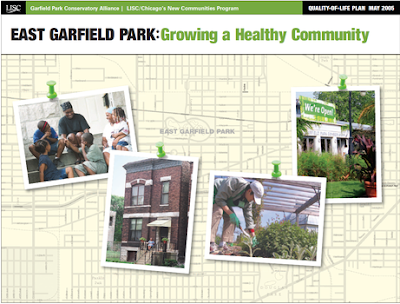"Art is Business" from the archives.
East Garfield Park Market Place, "Examing the State of Our Environment," 2007 curators uncovered value in the horse and carriage stalls abandoned for years; at the Garfield Park Conservatory, curators repurposed as marketplace curators invited six artists to install projects. Not pictured is John Song of Mobile Studios.
PopUp at Austin Public Library, SAIC Carol Frances Lung featured project, 2007 documenting and archiving projects after completing their investigation.
There's a lot of underutilized space in cities. Tactical urbanism can be used to uncover value and demonstrate how an underutilized space could be transformed to contribute to safety, community building, or economic goals.
1. Uncover the value
There's a lot of underutilized space in cities. Tactical urbanism can be used to uncover value and demonstrate how an underutilized space could be transformed to contribute to safety, community building, or economic goals. Artists can attend online summits and conferences and participate in art advocacy days.
2. Engage stakeholders from the beginning
Public outreach can help to generate new ideas, build community support, and improve local understanding of urban issues.
The importance of before and after photos and metrics. Photos are most compelling when the before and after shots match perfectly, so some advanced planning of location, angle, and time of day is critical. Capturing different angles—including several street-level photos from the height of an adult and the height of a child, in addition to aerial photos—can make this documentation even more compelling.
Photo OP with JP before becoming Governor of the State of Illinois at Gallery Guichard, reception fundraiser, with his running mate Juliana. Supporting the arts and business in Bronzeville
Photo Op with Rahm Emanuel, Mayor of Chicago, Near North West Arts Council, Laura Weathered, and Alan Emerson Hicks, Building dedication 2014.
4. Attract Attention
Using colorful materials, art, and creative promotional materials will help draw attention to an interim transformation. In addition, coordinating a shift with a planned event or organizing new programming can help to activate the space and attract media attention.
Daphne Burgess moderating a discussion for the Sojourner Truth African Heritage Museum
Call for artists and curators to have a platform for conceptualizing their idea and have a place to install the conversation in an installation.
5. Position projects to inspire programs or policies
Tactical urbanism can be used to pilot new approaches, which might transform policy or inspire new programs.
6. Have a seat at the table and become a stakeholder in community processes; artists can become part of the Task Force and visualize creative placemaking in the community where they live and work.
Meeting with City and State officials, we are constituents and have a voice.
2003 Switching Station Artist Lofts in East Garfield Park, Mayor Daley, supported artists' housing and attended the dedication ceremony and ribbon cutting.
Reference:
https://globaldesigningcities.org/2018/04/18/from-pop-up-to-permanent-five-lessons-in-tactical-urbanism/
The Global Designing Cities Initiative is a program of NACTO, a New York-based 501c3 non-profit organization. Our mission is to inspire a shift toward safe, sustainable, and healthy cities by transforming streets worldwide. We are a team of designers, planners, and urban strategists committed to working in support of city practitioners to get projects on the ground. We focus on empowering local officials and communities to become changemakers, equipping them with the knowledge, tools, and tactics needed to improve urban mobility and fundamentally change the role of streets in our cities. Our work is informed by the strategies and international best practices captured in the Global Street Design Guide.


















